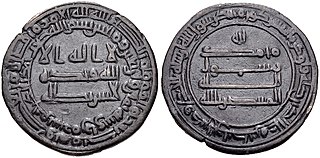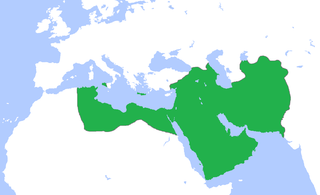Related Research Articles

The Tahirid dynasty was a dynasty, of Persian dehqan origin, that effectively ruled the Khorasan from 821 to 873 while other members of the dynasty served as military and security commanders for the city of Baghdad from 820 until 891. The dynasty was founded by Tahir ibn Husayn, a leading general in the service of the Abbasid caliph al-Ma'mun. Their capital in Khorasan was initially located at Merv but was later moved to Nishapur. The Tahirids have been described as the first independent Iranian dynasty after the fall of the Sassanian Empire. However, according Hugh Kennedy: "The Tahirids are sometimes considered as the first independent Iranian dynasty, but such a view is misleading. The arrangement was effectively a partnership between the Abbasids and the Tahirids." Instead, the Tahirids were loyal to the Abbasid caliphs and enjoyed considerable autonomy rather than being independent from the central authority. The tax revenue from Khorasan that was sent to the caliphal treasury was perhaps larger than those collected previously.

Abu Ja'far Muhammad, better known by his regnal title al-Muntasir bi-llah was the Caliph of the Abbasid Caliphate from 861 to 862, during the "Anarchy at Samarra". He was preceded by al-Mutawakkil and succeeded by al-Musta'in.

Al-Musta'in was the Abbasid Caliph from 862 to 866, during the "Anarchy at Samarra". After the death of previous Caliph, al-Muntasir, the Turkic military leaders held a council to select his successor. They were not willing to have al-Mu'tazz or his brothers; so they elected Ahmad ibn Muhammad أحمد بن محمد, a grandson of al-Mu'tasim, who took the regnal name al-Mustaʿin bi-llah.

Abū ʿAbd Allāh Muḥammad ibn Jaʿfar, better known by his regnal title al-Muʿtazz bi-ʾllāh was the Abbasid caliph from 866 to 869, during a period of extreme internal instability within the Abbasid Caliphate, known as the "Anarchy at Samarra".

Abū Isḥāq Muḥammad ibn al-Wāṯhiq, better known by his regnal name al-Muhtadī bi-'llāh, was the Caliph of the Abbasid Caliphate from July 869 to June 870, during the "Anarchy at Samarra".
Abu Ahmad Talha ibn Ja'far, better known by his laqab as al-Muwaffaq bi-Allah, was an Abbasid prince and military leader, who acted as the de facto regent of the Abbasid Caliphate for most of the reign of his brother, Caliph al-Mu'tamid. His stabilization of the internal political scene after the decade-long "Anarchy at Samarra", his successful defence of Iraq against the Saffarids and the suppression of the Zanj Rebellion restored a measure of the Caliphate's former power and began a period of recovery, which culminated in the reign of al-Muwaffaq's own son, the Caliph al-Mu'tadid.

The Abbasid civil war of 865–866, sometimes known as the Fifth Fitna, was an armed conflict during the "Anarchy at Samarra" between the rival caliphs al-Musta'in and al-Mu'tazz, fought to determine who would gain control over the Abbasid Caliphate. The war, which lasted for about a year, largely revolved around a prolonged siege of Baghdad and ended with al-Mu'tazz as sole caliph. Al-Musta'in was abandoned by his supporters and forced to abdicate; in spite of a guarantee that his life would be spared, he was executed shortly afterward.

The term "Anarchy at Samarra" refers to the period 861–870 in the history of the Abbasid Caliphate, which was marked by extreme internal instability and the violent succession of four caliphs, who became puppets in the hands of powerful rival military groups.
The Maghariba were a regiment in the regular army of the Abbasid Caliphate. The unit was formed in the early ninth century A.D. and consisted of soldiers who were of North African origin. During their history, the Maghariba participated in several military campaigns and played a significant role in the politics of the central government.
The Faraghina were a regiment in the regular army of the Abbasid Caliphate which was active during the ninth century A.D. Consisting of troops who originated from the region of Farghana in Transoxiana, the Faraghina participated in several military campaigns and played a significant role in the politics of the central government, especially during the Anarchy at Samarra.
Abu Ja'far Ahmad ibn Isra'il al-Anbari was a prominent civil officer of the Abbasid Caliphate in the mid-9th century, serving as vizier during the caliphate of al-Mu'tazz. His career came to a sudden end when he was arrested on the orders of the Turkish general Salih ibn Wasif in May 869, and he was killed four months later after being repeatedly subjected to torture.
The Ushrusaniyya were a regiment in the regular army of the Abbasid Caliphate. Formed in the early ninth century A.D., the unit consisted of soldiers who were originally from the region of Ushrusana in Transoxiana. The Ushrusaniyya initially served under the prominent general al-Afshin, but they remained active after his downfall, and are frequently mentioned during the period known as the Anarchy at Samarra.
The Milakid family, also known as the Mikalis, was a prominent Iranian aristocratic family of Khorasan from the 9th century to the 11th century. They were descended from the pre-Islamic nobility of Samarkand.
Abu'l-Abbas Muhammad ibn Abdallah ibn Tahir was a Tahirid who served the Abbasid Caliphate as governor and chief of police of Baghdad from 851 until his death, during a particularly troubled period in the city's history, which included its siege during the civil war of 865–866, in which he played a major role. He also served in the 860s as governor of Iraq, Mecca and Medina, and was noted as a scholar, a poet and a patron of artists and scholars.
Muhammad ibn Mikal was an Iranian nobleman from the Mikalid family, who served as a military commander of the Tahirid dynasty. He was the son of Mikal, a nobleman who had left Iraq and settled in Khurasan, and could trace his descent back to the Sogdian ruler Divashtich. Muhammad also had a brother named Shah ibn Mikal, who, during his early career, along with Muhammad, played an important role under the Tahirid ruler Abdallah ibn Tahir al-Khurasani. In 864, the Alid Hasan ibn Zayd conquered Tabaristan from the Tahirids, while another Alid named Muhammad ibn Ja'far ibn al-Hasan expelled the Tahirid governor of Ray, and captured the city. The Tahirid ruler Muhammad ibn Tahir shortly sent an army from Khurasan under Muhammad ibn Mikal, who managed to recapture the city and capture Muhammad ibn Ja'far. Hasan, however, quickly made a counter-attack under his Dailamite general Wajin, who managed to rout the army of Muhammad ibn Mikal, and kill the latter.
Muzahim ibn Khaqan was an Abbasid Turkic military commander in the service of the Abbasid Caliphate. He was appointed governor of Egypt in 867, and held that position until his death in the following year.
Abu Ahmad Ubaydallah ibn Abdallah ibn Tahir was a ninth century Tahirid official and military officer. He was the last major Tahirid to hold high office, having served as the governor of Baghdad at various points between 867 and 891.
Ja'far ibn Dinar ibn Abdallah al-Khayyat was a ninth-century military commander for the Abbasid Caliphate.
Al-Husayn ibn Isma'il ibn Ibrahim ibn Mus'ab was a ninth century army commander in the service of the Abbasid Caliphate. He was particularly active during the period known as the Anarchy at Samarra (861–870).
The shākiriyya were a regular cavalry regiment of the Abbasid Caliphate in the "Samarra period" in the 9th century. Probably of Khurasani and Iranian origin, they were rivals of the Turkish guard, and played a major role in the court conflicts that marked the decade of the "Anarchy at Samarra" in the 860s.
References
- ↑ Kennedy 1984, p. 764.
- ↑ Al-Tabari 1985–2007, v. 35: p. 48.
- ↑ Al-Tabari 1985–2007, v. 36: p. 115.
- 1 2 Kennedy 2001, p. 202.